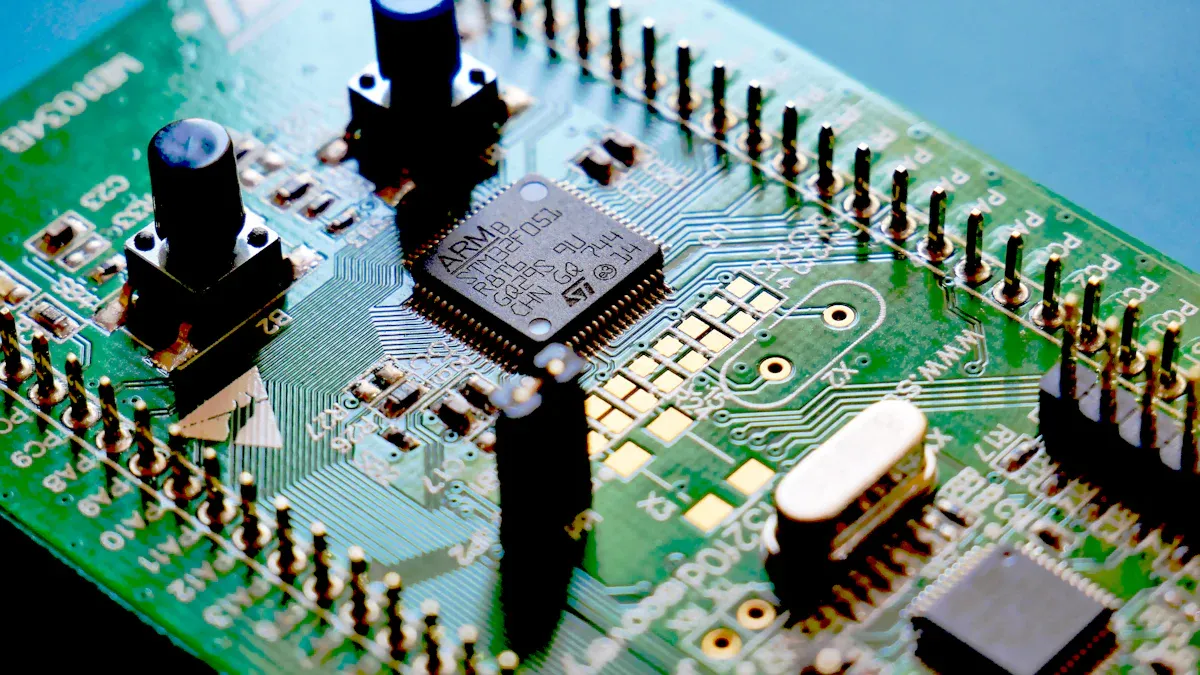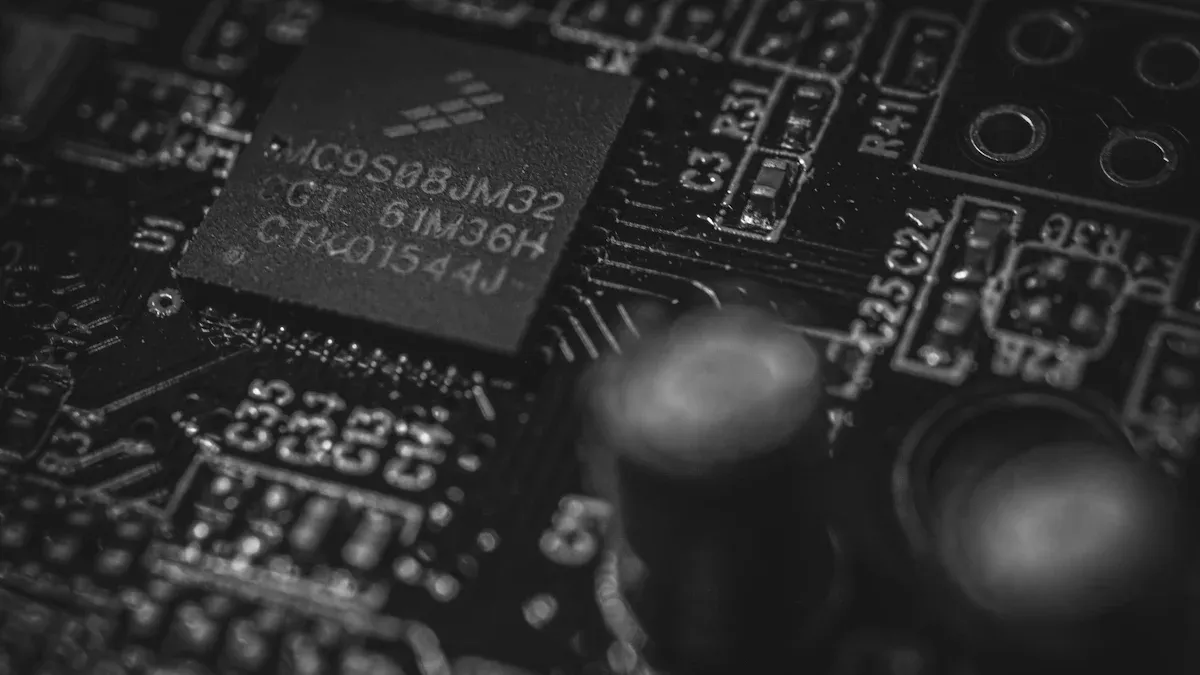What Is a 100LQFP Voice Processor Chip and Its Key Features

A VOICE PROCESSOR 100LQFP chip combines advanced voice processing technology with a 100-lead quad flat package. This chip manages audio signals and supports clear sound in many devices. Engineers select the VOICE PROCESSOR 100LQFP chip for its high pin count and reliable surface mounting. The chip stands out because it helps products deliver high-quality voice features in a compact design.
Many modern electronics rely on the VOICE PROCESSOR 100LQFP chip to enable smart audio functions.
Key Takeaways
The 100LQFP package has 100 pins and a thin, square design that fits powerful chips into small devices.
Voice processor chips improve sound quality by handling audio tasks like noise reduction and voice recognition efficiently.
The VOICE PROCESSOR 100LQFP chip connects easily to other audio parts and supports many smart features in devices.
Manufacturers benefit from simpler designs, faster production, and cost savings when using this chip.
Users enjoy clearer sound, smart voice control, and reliable device performance in slim, easy-to-carry products.
100LQFP Package

Overview
The 100LQFP package stands for "100-lead Low-Profile Quad Flat Package." This type of chip package has a square shape with leads, or metal pins, that extend from all four sides. Each side holds many leads, which connect the chip to the circuit board. The "100" in the name means the package has 100 pins in total. These pins allow the chip to handle many signals at once. The low-profile design keeps the package thin, making it a good choice for devices where space matters.
The 100LQFP package helps engineers fit powerful chips into small spaces without losing important features.
Design
Engineers designed the 100LQFP package to support complex integrated circuits. The leads have a fine pitch, which means they sit close together. This design allows for a high pin count in a small area. The package usually measures only a few millimeters thick, so it fits well in slim devices. The leads form a grid pattern around the chip, making it easy to solder onto a circuit board. The flat, exposed surface of the package helps heat move away from the chip, which keeps it cool during use. Many industries, such as automotive and communications, use this package because it balances size and function.
Square-shaped body with leads on all four sides
Fine lead pitch for high pin density
Low overall height (about 1.4mm)
Flat, exposed surface for better heat dissipation
Symmetrical layout for easy soldering
Benefits
The 100LQFP package offers several advantages for both designers and manufacturers:
Compact design saves space on the circuit board
High pin count supports multiple interfaces and complex functions
Surface-mount technology allows for modern, automated assembly
Good thermal performance keeps chips reliable
Easy inspection and soldering due to visible leads
These features make the 100LQFP package a popular choice for voice processor chips and other advanced electronics. Devices can stay small and thin while still offering powerful features and reliable performance.
Voice Processor Chip

Purpose
A voice processor chip manages and improves audio signals in electronic devices. It acts as the brain for sound, making sure voices and music sound clear and natural. These chips use advanced technology to process many audio tasks at once. They can handle high-resolution audio streams, trigger voice commands, and recognize speech, all while using very little power.
Modern voice processor chips use AI-driven algorithms to boost sound quality and cancel out unwanted noise. They can adjust sound levels automatically and reduce background sounds, which helps users hear voices more clearly. The chip’s design includes special units called multiply-accumulation units (MACs) that make audio processing faster and more accurate. These chips also use efficient data transport methods, which help save energy and keep devices running longer.
Voice processor chips play a key role in delivering high-quality audio experiences in today’s smart devices.
Some important features of voice processor chips include:
Processing complex audio tasks like multi-channel sound and speech recognition at low power
Doubling or even quadrupling processing power to meet new audio standards
Using scalable designs that can adapt to different device needs
Supporting new audio interfaces that connect to many audio parts with fewer pins
Applications
Voice processor chips appear in many everyday devices. They help smart speakers, smartphones, and multimedia systems deliver clear and responsive audio. These chips also power voice assistants, gaming consoles, and even cars with voice control features.
The number of digital voice assistants in use is expected to reach 8 billion by 2024.
Over 50% of North American homes use voice-enabled devices, with Alexa and Google Assistant leading the market.
The consumer electronics sector, including smartphones and smart speakers, made up more than 33% of the intelligent voice control chip market revenue in 2024.
The U.S. market for intelligent voice control chips reached $1.10 billion in 2024 and is set to double by 2032.
Voice processor chips support a wide range of applications, making them essential for modern electronics that rely on voice and audio features.
VOICE PROCESSOR 100LQFP Chip Features
Audio Processing
The VOICE PROCESSOR 100LQFP chip uses advanced digital signal processing (DSP) cores to handle audio tasks quickly and accurately. These DSP cores process sound in real time, which helps devices deliver clear and natural audio. The chip often includes integrated memory, which stores audio data and instructions for fast access. Internal buses move data between different parts of the chip, making sure audio signals do not get delayed.
Many VOICE PROCESSOR 100LQFP chips support floating-point operations. This feature allows the chip to handle complex audio effects and high-resolution sound without losing detail. Devices that use these chips can play music, process voice commands, and record audio with high quality. The chip’s design helps reduce power use, so devices can run longer on a single charge.
DSP cores and floating-point support help the chip deliver crisp, clear sound in many devices.
Interfaces
The VOICE PROCESSOR 100LQFP chip connects to other parts of a device through many types of interfaces. Common interfaces include I2S (Inter-IC Sound) and SPDIF (Sony/Philips Digital Interface). These interfaces move digital audio signals between the chip and other components, such as microphones, speakers, and amplifiers.
The SPDIF interface uses precise timing parameters, such as skew and transition times, to ensure accurate data transfer.
I2S is widely used in audio devices because it supports many audio standards and works with different types of audio chips.
Some chips, like the i.MX RT1024 MCU, offer multiple audio interfaces, including I2S, AC97, TDM, and codec/DSP connections.
Detailed timing diagrams for SPDIF clocks show that the chip design focuses on timing accuracy and stable operation.
These features make the VOICE PROCESSOR 100LQFP chip reliable and compatible with many audio systems. Devices can use these interfaces to connect to a wide range of audio equipment.
Integration
The VOICE PROCESSOR 100LQFP chip stands out for its high level of integration. Designers combine many functions into a single chip, which saves space and reduces the number of parts needed in a device. This integrated design improves performance, lowers power use, and makes devices more reliable.
Engineers use several metrics to measure how well the chip integrates its features:
Metric | What It Measures |
|---|---|
Performance | How fast the chip processes audio |
Power | How much energy the chip uses |
Area | How much space the chip takes up |
Timing delays in the chip | |
Total Negative Slack | Total timing issues across all paths |
Number of Violating Paths | How many signal paths miss timing |
Designers also look at wire length and congestion to make sure the chip works well in real devices. End-to-end testing, from design to final product, helps confirm that the chip meets all performance and integration goals. Benchmarking with modern tools shows that only chips with strong final metrics deliver the best results.
Special Functions
The VOICE PROCESSOR 100LQFP chip offers many special functions that improve the user experience. These features help devices deliver clear, high-quality sound in different environments.
Noise Reduction: The chip removes unwanted background sounds, making voices easier to hear.
Echo Cancellation: It stops echoes from interfering with calls or recordings.
Voice Recognition: The chip can detect and understand spoken commands, which is important for smart devices.
High-Quality Playback and Recording: Devices can play music and record audio with rich detail and low distortion.
Special functions like noise reduction and voice recognition make the VOICE PROCESSOR 100LQFP chip a key part of modern smart devices.
These features allow manufacturers to build products that respond to voice commands, deliver crisp audio, and work well in noisy places. The VOICE PROCESSOR 100LQFP chip helps both simple and advanced devices offer better sound and smarter features.
Advantages
For Manufacturers
Manufacturers gain several benefits when they use the VOICE PROCESSOR 100LQFP chip in their products. This chip helps them create devices that stand out in the market.
Simplified Design: The high level of integration reduces the number of separate parts. Engineers can design smaller and lighter products.
Faster Production: Surface-mount technology and the 100LQFP package support automated assembly lines. This speeds up manufacturing and lowers labor costs.
Cost Savings: Fewer components mean less money spent on parts and assembly. The chip’s reliability also reduces returns and repairs.
Flexible Applications: The chip supports many interfaces and functions. Manufacturers can use it in different products, from smart speakers to automotive systems.
Quality Assurance: The visible leads and flat package make inspection easier. Quality control teams can spot issues quickly.
Manufacturers who choose the VOICE PROCESSOR 100LQFP chip often see faster time-to-market and improved product reliability.
For Users
Users also enjoy many advantages when devices include this chip. The chip improves the way people interact with technology every day.
Benefit | What It Means for Users |
|---|---|
Clearer Sound | Voices and music sound crisp and clear |
Smart Features | Devices respond to voice commands |
Fewer Distractions | Noise reduction blocks background noise |
Reliable Performance | Devices work well for a long time |
Sleek Design | Products stay slim and easy to carry |
Devices with this chip often last longer and need fewer repairs.
Users can enjoy hands-free control and better voice recognition.
The chip helps devices work well in noisy places, like busy homes or cars.
With the VOICE PROCESSOR 100LQFP chip, users get smarter, more reliable, and more enjoyable technology experiences.
The VOICE PROCESSOR 100LQFP chip combines advanced audio processing with a compact design. This chip supports clear sound and smart features in many modern devices. Engineers use it in products like smart speakers, phones, and cars. Manufacturers benefit from easy assembly and cost savings. Users enjoy better sound and reliable performance.
Key benefits:
High-quality audio
Smart voice features
Reliable operation
The VOICE PROCESSOR 100LQFP chip helps shape the future of smart electronics.
FAQ
What does 100LQFP mean in a voice processor chip?
100LQFP stands for "100-lead Low-Profile Quad Flat Package." This package has 100 pins and a flat, square shape. Engineers use it to fit powerful chips into small devices.
Where do people find voice processor 100LQFP chips?
People find these chips in smart speakers, phones, cars, and multimedia devices. Many modern electronics use them to process sound and support voice commands.
Why do manufacturers choose the 100LQFP package?
The 100LQFP package saves space and supports many connections. Manufacturers like its easy assembly and good heat control. This package helps them build slim, reliable products.
What special features do these chips offer?
Noise reduction
Echo cancellation
Voice recognition
High-quality audio playback
These features help devices deliver clear sound and smart voice functions.
See Also
Understanding IC Voice Processors And Their Functionality
Key Features And Functions Of IC Audio Signal Processors
How Programmable Logic Chips Operate And Their Uses
